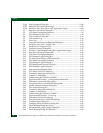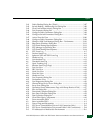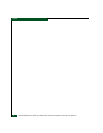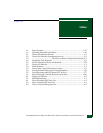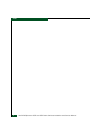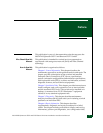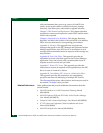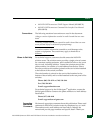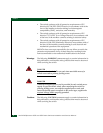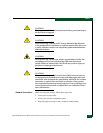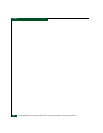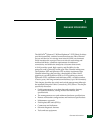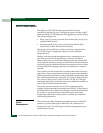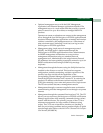
6
McDATA® Sphereon 3032 and 3232 Fabric Switches Installation and Service Manual
Preface
Ordering Printed
Manuals
To order a paper copy of this manual, submit a purchase order as
described in Ordering McDATA Documentation Instructions, which is
found on McDATA’s web site, http://www.mcdata.com. To obtain
documentation CD-ROMs, contact your sales representative.
Trademarks The following terms, indicated by a registered trademark symbol (®)
or trademark symbol (™) on first use in this publication, are
trademarks of McDATA Corporation or SANavigator, Inc. in the
United States or other countries or both:
Registered Trademarks
Trademarks
McDATA
®
Sphereon™
Fabricenter
®
OPENconnectors™
OPENready
®
SANpilot™
SANavigator
®
SANtegrity™
All other trademarked terms, indicated by a registered trademark
symbol (®) or trademark symbol (™) on first use in this publication,
are trademarks of their respective owners in the United States or
other countries or both.
Laser Compliance
Statement
Laser transceivers in the switches are tested and certified in the
United States to conform to Title 21 of the Code of Federal
Regulations (CFR), Subchapter J, Parts 1040.10 and 1040.11 for Class 1
laser products. Elsewhere, the transceivers are tested and certified to
be compliant with International Electrotechnical Commission
IEC825-1 and European Norm EN60825-1 and EN60825-2 regulations
for Class 1 laser products.
Class 1 laser products are not considered hazardous. The transceivers
are designed such that there is never human access to laser radiation
above a Class 1 level during normal operation or prescribed
maintenance conditions.
Federal
Communications
Commission (FCC)
Statement
The switches generate, use, and can radiate radio frequency energy,
and if not installed and used in accordance with the instructions
provided, may cause interference to radio communications. The
switches have been tested and found to comply with the limits for
Class A computing devices pursuant to Subpart J of Part 15 of the
FCC Rules, which are designed to provide reasonable protection
against such interference in a commercial environment. Operation of
this equipment in a residential area is likely to cause interference in
which case the user, at his or her own expense, will take whatever



